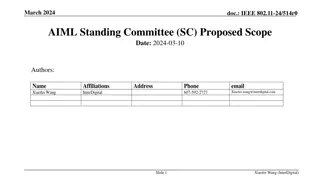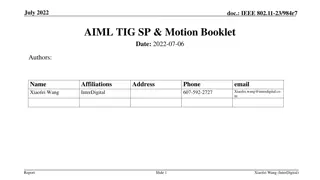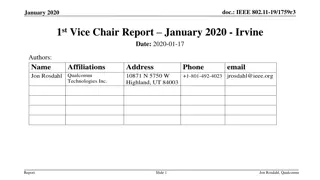IEEE 802.11-23/2092r2 AIML Report Summary
This document conveys the findings of the AIML Technical Report for IEEE 802.11 networks. It covers AIML use cases in WLANs, performance enhancement opportunities, IEEE 802.11 feature requirements, standard impacts, and proposed next steps for AIML integration. AIML's significance in various technologies, particularly wireless communications, is highlighted along with the progress and potential benefits it offers to IEEE 802.11 networks. The AIML TIG's objectives, progress since July 2022, and the current version of the report are discussed.
Download Presentation

Please find below an Image/Link to download the presentation.
The content on the website is provided AS IS for your information and personal use only. It may not be sold, licensed, or shared on other websites without obtaining consent from the author. Download presentation by click this link. If you encounter any issues during the download, it is possible that the publisher has removed the file from their server.
E N D
Presentation Transcript
November 2023 doc.: IEEE 802.11-23/2092r2 AIML Report and Next Steps for AIML Related Work Date: 2023-11-10 Authors: Name Xiaofei Wang Ming Gan Liangxiao Xin Zinan Lin Rui Yang Aiguo Yan Junghoon Suh Ziyang Guo Marco Hernadez Peng Liu Federico Lovison Jerome Henry Juan Carlos Zuniga Sukrit Dasgupta Affiliations InterDigital Huawei Self InterDigital InterDigital Ubilinx Huawei Huawei YRP-IAI, Japan; CWC Oulu Univ. Finland, NICT, Japan Huawei Cisco Cisco Cisco Cisco Address Phone 607-592-2727 email Xiaofei.wang@interdigital.com Slide 1 Xiaofei Wang (InterDigital)
November 2023 doc.: IEEE 802.11-23/2092r2 Authors (continued): Name Eunsung Jeon Ziming He Szymon Szott Affiliations Samsung Samsung AGH University of Science and Technology AGH University of Science and Technology UPF Barcelona New H3C Huawei Toyota Motor Toyota Motor Address Phone email Katarzyna Kosek-Szott Boris Bellalta Lei Zhou Stephen McCann Jing Ma Lei Zhong Slide 2 Xiaofei Wang (InterDigital)
November 2023 doc.: IEEE 802.11-23/2092r2 Abstract This contribution provides a summary of the AIML TIG Technical Report The technical report includes: Identified AIML Use case for IEEE 802.11 Use case that enables AIML in WLANs (hence making IEEE 802.11 deployment-ready for AIML) Use cases that leverage AIML for performance enhancement for WLANs Feasibilities, KPIs and requirements for IEEE 802.11 features required to address these use cases. Standard impact to the IEEE 802.11 specifications Discussion of the next steps for AIML related work in IEEE 802.11. Slide 3 Xiaofei Wang (InterDigital)
November 2023 doc.: IEEE 802.11-23/2092r2 Background (1/2) AIML has seen tremendous progress in the past decade and has been used in many areas of technologies Medical diagnosis Speech recognition Computer vision Wireless communications Much of the AIML related traffic (including traffic for model distribution) is expected to be carried by WLANs In addition, IEEE 802.11 networks and devices may benefit from utilization of AIML algorithms to improve performances and user experience Various wireless communications technologies are developing/have developed specifications work for AIML, e.g., 3GPP has introduced AIML-based network functionality in Rel-15 (5G, initial release in 2017) and it is further enhanced in Rel-16 and Rel-17 AIML-related technology for air interface has been a study item for Rel-18 and is very likely becoming a work item in Rel-19 starting in 2024 Slide 4 Xiaofei Wang (InterDigital)
November 2023 doc.: IEEE 802.11-23/2092r2 Background (2/2) The AIML TIG started working in July 2022 to: (a) describe use cases for Artificial Intelligence/Machine Learning (AI/ML) applicability in 802.11 systems and (b) investigate the technical feasibility of features enabling support of AI/ML. The current version of the AIML TIG report can be found in [2] Expected to be updated with additional privacy considerations for two of the use cases Slide 5 Xiaofei Wang (InterDigital)
November 2023 doc.: IEEE 802.11-23/2092r2 Summary of the the AIML TIG Technical Report (1/3) The AIML TIG has studied two categories of AIML use cases for WLANs One use case that enables AIML deployment in WLANs: Efficient AIML model sharing [5]: including 1) models that are used for enhancing WLAN performances 2) models used for other AIML applications that are carried by the WLAN networks Four use cases that that leverage AIML techniques to enhance the performance of WLANs AIML-based CSI feedback compression/enhancement [3] Deep-learning based distributed channel access [4] Efficient AIML model sharing [5] AIML-based roaming enhancement [6] AIML-based multi-AP coordination [7] For each use case, the following aspects are being defined: Standards impact to the IEEE 802.11 specifications: to provide an estimate of scope of work needed KPIs Requirements Technical feasibility * Please see appendix for the details for each of the use cases Slide 6 Xiaofei Wang (InterDigital)
November 2023 doc.: IEEE 802.11-23/2092r2 Summary of the the AIML TIG Technical Report (2/3) Conclusions In order to enable and support AIML algorithms in IEEE 802.11 network and devices and in order to leverage AIML techniques to enhance IEEE 802.11 network performance, features that are needed to address the AIML use cases identified in this technical report can be achieved with a reasonable amount of work within the scope of the IEEE 802.11 WG. In order to support generic AIML algorithms in IEEE 802.11 networks and devices, general management and support features, such as capability indication, control and model distribution of AIML technology deployment are needed in the IEEE 802.11 specifications for all AIML-based use cases. Slide 7 Xiaofei Wang (InterDigital)
November 2023 doc.: IEEE 802.11-23/2092r2 Summary of the the AIML TIG Technical Report (3/3) Recommendations IEEE 802.11 should commence further study and work related to AIML technologies. In particular, efforts and standards changes to make the IEEE 802.11 standards deployment-ready (i.e., general support and management) for AIML techniques should be defined. IEEE 802.11 should also consider defining features and capabilities in which AIML techniques are leveraged to enhance network performance and user experience when using IEEE 802.11 networks and devices. Privacy considerations should also be studied during further AIML related work. Slide 8 Xiaofei Wang (InterDigital)
November 2023 doc.: IEEE 802.11-23/2092r2 Next Steps for AIML related work in IEEE 802.11 Based on the recommendations Make the IEEE 802.11 standards deployment-ready (i.e., general support and management) for AIML techniques. AIML technology and traffic are coming to IEEE 802.11 networks and devices Other wireless communication specifications are progressing rapidly, e.g., 3GPP is expected to define AIML related specifications for air interface starting in 2024 Operators may expect similar manageability of AIML techniques for IEEE 802.11, particularly for WiFi offloading and WiFi calling IEEE 802.11 should consider defining features and capabilities in which AIML techniques are leveraged to enhance network performance and user experience when using IEEE 802.11 networks and devices. Such work may be in the form of a SG aiming to provide specification changes Identified standards impact to the IEEE 802.11 standards for features targeting the various AIML use cases can be achieved with a reasonable scope of work Slide 9 Xiaofei Wang (InterDigital)
November 2023 doc.: IEEE 802.11-23/2092r2 References [1] 11-22/597r3: May 2022 Working Group Motions, May 18, 2022 [2] 11-22/987r24: AIML TIG Technical Report Draft, Nov 2023 [3] 11-22/1934r5: Proposed AIML TIG Technical Report Text for the CSI Feedback Compression Use Case [4]11-22/2119r1: Proposed AIML TIG Technical Report Text for the Distributed Channel Access Use Case [5] 11-23/0050r2: Proposed AIML TIG Technical Report Text for the AIML Model Sharing Use Case [6] 11-23/475r4: Proposed IEEE 802.11 AIML TIG Technical Report Text for the AIML-based Roaming Enhancements Use Case [7] 11-23/227r4: Proposed IEEE 802.11 AIML TIG Technical Report Text for the Multi-AP Coordination Use Case [8] 11-23/1072r0: AIML methodology for dynamic spectrum sharing and coexistence Slide 10 Xiaofei Wang (InterDigital)
November 2023 doc.: IEEE 802.11-23/2092r2 Appendix Slide 11 Xiaofei Wang (InterDigital)
November 2023 doc.: IEEE 802.11-23/2092r2 Highlights of AIML Use Cases Identified for WLANs (1) We highlight in this report AIML use cases that have already been motioned into the AIML TIG Technical Report [2] AIML-based CSI feedback compression/enhancement [3] Deep-learning based distributed channel access [4] Efficient AIML model sharing [5] AIML-based roaming enhancement [6] AIML-based multi-AP coordination [7] Slide 12 Xiaofei Wang (InterDigital)
November 2023 doc.: IEEE 802.11-23/2092r2 Highlights of AIML Use Cases Identified for WLANs (2) Efficient AIML model sharing/distribution [5] Efficient AIML model distribution is essential for many AIML-based operations in WLANs and for performance of WLANs In centralized learning/federated learning, large amount of traffic are used to distribute AIML models/training data among participating devices (STAs and APs), in UL, DL and P2P links Efficient AIML model distribution protocols are needed to enable support AIML operations Including sharing of all AIML models (e.g., for other applications; these model sharing is expected to be carried by WLANs anyway), not just for models used to improve WLAN performance (such as NN models) Feasibility: Efficient AIML model distribution can leverage the broadcast nature of WLANs 802.11bc defines UL/DL broadcast services for both associated and unassociated STAs/APs, providing a good set of baseline tools for AIML model distribution Standards impact to the IEEE 802.11 specifications: Architecture that enables AIML model sharing on the MAC layer Signaling and protocols related to AIML model sharing support/capability indication and management KPI: medium occupation time saving compared to model sharing using application layer data Slide 13 Xiaofei Wang (InterDigital)
November 2023 doc.: IEEE 802.11-23/2092r2 Highlights of AIML Use Cases Identified for WLANs (3) AIML-based CSI Feedback Compression/enhancement [3] Sounding procedures in WLANs represent large overhead particularly with potential new features: Higher number of spatial streams, e.g., 16 Multi-AP features such as joint transmissions Studies show that AIML algorithms may efficiently reduce CSI feedback/improve system throughput using unsupervised learning algorithms to significantly reduce CSI feedback into clusters while maintaining similar PER performance E.g., AIML-aided dual CSI compression combines codebook and Givens Rotation which leverage K-means ML algorithm E.g., AIML algorithm may be used to reduce the computation complexity for CSI feedback, such as quantization of the right singular matrix using an autoencoding-based algorithm Standards impact to the IEEE 802.11 specifications : Additional signaling (or new signaling design) between AP an STAs required by AIML process to provide (e.g., newly designed) feedback and/or cluster information AIML model sharing (also see AIML Model Sharing Use case) KPIs: CSI airtime reduction/additional AIML process overhead PER Computation complexity/latency Storage needed for AIML models Slide 14 Xiaofei Wang (InterDigital)
November 2023 doc.: IEEE 802.11-23/2092r2 Highlights of AIML Use Cases Identified for WLANs (4) Deep-learning based distributed channel access [4] Performances of traditional WLAN channel access designs such as DCF degrade in dense deployment, unable to support stringent QoS requirements such as Ever increasing throughput Low latency Study has shown that deep learning algorithms can efficiently increase throughput and reduce latency and jitter while maintain fairness to other devices E.g., using Deep reinforcement learning for contention window optimization E.g., AIML algorithm selects whether to transmit after the channel has been idle for DIFS Standards impact to the IEEE 802.11 specifications : Signaling and protocols related to parameter exchange between AP and non-AP STAs, e.g., capability indication, data report to facilitate training, neural networks parameters distribution, etc. KPIs: Throughput improvement Latency and jitter reduction Additional complexity Slide 15 Xiaofei Wang (InterDigital)
November 2023 doc.: IEEE 802.11-23/2092r2 Highlights of AIML Use Cases Identified for WLANs (5) AIML Enhanced Roaming [6] Roaming may occur frequently in dense AP deployments, affecting device battery lifetime and user experience Multi-AP networks commonly see a high level of roaming events A large number of roaming candidate APs/channels in use can cause STA scanning process to take a long time Candidate APs in 802.11k neighbor report are useful, however, not all RF neighbor APs are equally relevant for roaming Efficient AIML techniques may be applied to Augment 802.11k neighbor report with weight for each candidate AP for prioritization of scanning Assist the STA to find the optimal mid-point between APs to start scanning and roam Standards impact to the IEEE 802.11 specifications : Enhanced 802.11k neighbor report with weight of roaming neighbor AP candidates Triggering STAs to scan at mid-point between APs may require enhancement of BTM request frame Feedback for roaming recommendation by using enhanced BTM response frame KPI: Scanning/Roaming time Roaming failure rate MCS distribution/Retry rate during a BSS transition RSSI at reattach time Slide 16 Xiaofei Wang (InterDigital)
November 2023 doc.: IEEE 802.11-23/2092r2 Highlights of AIML Use Cases Identified for WLANs (6) AIML based Multi-AP Transmission [7] In OBSS scenarios, multi-AP coordinated transmissions can improve network performance Multi-AP coordinated transmission is expected to be a feature of UHR SG/802.11bn Configuring such transmissions is challenging due to varying network and radio conditions and outside interference (neighboring, non-coordinating BSS) AIML models can be learnt and help make decisions/predict Find AP-STA pairs, select multi-AP transmission schemes and associated parameters, select when to transmit, etc. Exact multi-AP schemes depend on work in UHR/802.11bn but may include C-TDMA, C-OFDMA, C-SR, C-BF and JT Standards impact to the IEEE 802.11 specifications : Additional signaling for exchanging training data/measurement reports/model sharing KPI: Network performance metrics (throughput, latency and jitter, power efficiency) measured at the BSS level but also aggregated over the whole multi-AP network Fairness to ensure that all users are fairly served AIML overhead additional signaling, computational complexity, and learning latency Slide 17 Xiaofei Wang (InterDigital)























